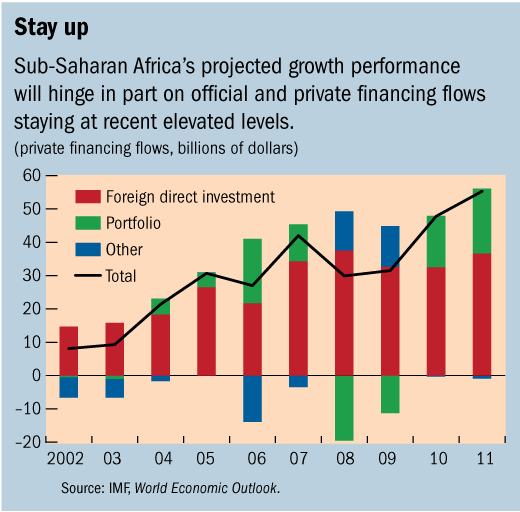
Typical street scene in Santa Ana, El Salvador. (Photo: iStock)
IMF Survey: Sub-Saharan Africa’s Economies Set for Broad-based Growth
October 25, 2010
- Good growth prospects for 2010, 2011 but fiscal deficits have risen
- Domestic demand is resilient, exports increasingly targeted toward Asia
- Main risks stem from unbalanced global recovery
Sub-Saharan Africa's accelerating economic growth is expected to be broad based in 2010 and 2011, the IMF said in its latest regional forecast.

Clothing vendor in Nairobi, Kenya: Africa’s domestic demand is set to stay strong on rising real incomes, sustained private and public investment (IMF photo)
REGIONAL ECONOMIC OUTLOOK
Strong domestic demand and resurgent exports are projected to boost average growth rates in the region to 5–5 ½ percent, near to the high levels recorded before the global economic slowdown.
The key explanation for the resilience of sub-Saharan Africa has been the generally strong economic position of countries going into the global financial crisis. This allowed counter-cyclical fiscal and monetary policies to be put in place to soften the impact of the global downturn.
Nevertheless, the IMF’s Regional Economic Outlook for sub-Saharan Africa notes that the global crisis has left a legacy of elevated unemployment levels in countries with more developed manufacturing sectors and, more generally, of weakened fiscal balances. Credit growth also remains subdued.
Fiscal policy shift
In most countries, growth rates have returned close to potential and domestic demand is expected to remain strong on the basis of rising real incomes and sustained private and public investment. However, the trajectory of fiscal balances in some countries is not consistent with medium-term financial and debt sustainability. The Regional Economic Outlook suggests therefore that now is an opportune time in some cases to adjust medium-term spending and revenue plans and to start withdrawing any recent fiscal stimulus measures.
Continued fiscal support is likely needed only in a handful of countries with below-potential growth and no debt sustainability risk.
As long as inflation and credit growth stay low, there is little urgency to reverse interest rate cuts.
Over the long term, the report advocates that improving public services and infrastructure, strengthening financial systems, and maintaining an open business climate should remain paramount policy objectives.
Risks
The Regional Economic Outlook draws attention to the downside risks that remain for the global economy, with only a shaky recovery so far evident in advanced countries and continued fragility in financial markets.
If a significant further global slowdown does occur, it could dampen growth quite markedly in sub-Saharan Africa. This would delay efforts to rebuild the sound policy buffers that helped to shield the region from the worst effects of the global crisis. In addition, a heavy political calendar of elections in as many as 17 countries during 2011 could delay some reforms.
Trade with developing Asia
Sub-Saharan Africa’s trading patterns have shown some dramatic shifts during the last few years toward China and other parts of developing Asia, the report said. These shifts were so marked that, by 2009, China’s share in the sub-Saharan Africa’s total exports and imports exceeded that between China and most other regions in the world.
Exports of goods and services make relatively small contributions to aggregate demand in most sub-Saharan African countries. Europe and other advanced countries remain the region’s dominant trading partners. However, in a minority of countries— including the major natural resource exporters— the impact of developing Asia on global export demand and commodity prices is expected to be significant in both the short and long term.
Overall, trade with Asia is therefore likely to be an increasingly important factor in maintaining growth for the region on its current trajectory. But the key drivers of African growth are likely to remain: political stability; the business climate, including the prudent exploitation of natural resources; and the quality of economic management.

Promising prospects
With the expansion in global output set to continue, IMF country teams are projecting that, barring shocks, most countries will maintain strong growth into 2011. Fiscal balances are also expected to improve somewhat in 2011 relative to 2010.
Sub-Saharan Africa’s growth performance will hinge in part on official and private financing flows staying at their recent elevated levels (see chart). If extended risk aversion or fiscal retrenchment in Europe was to lead to a sharp dropoff in donor support, this would almost certainly hamper the envisaged acceleration in GDP growth.


